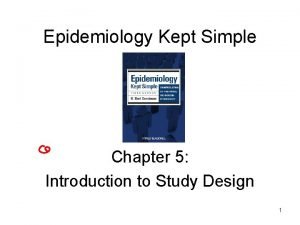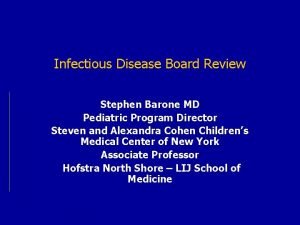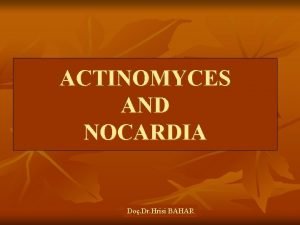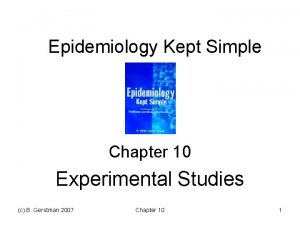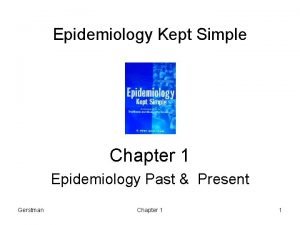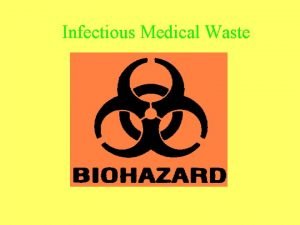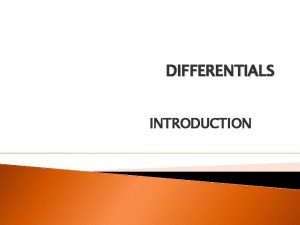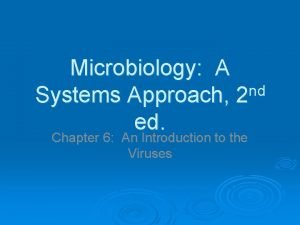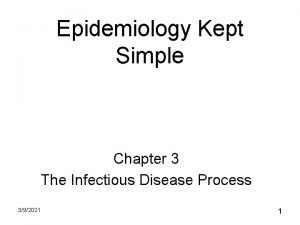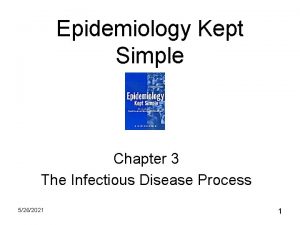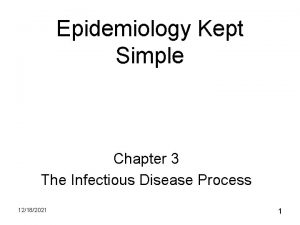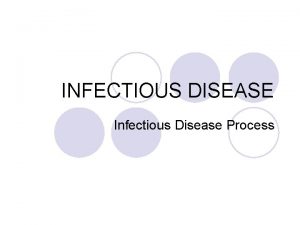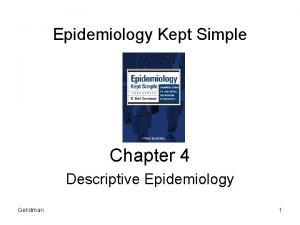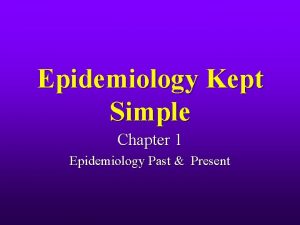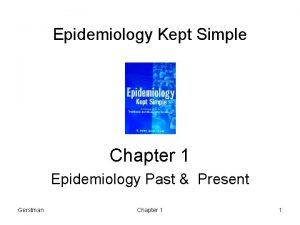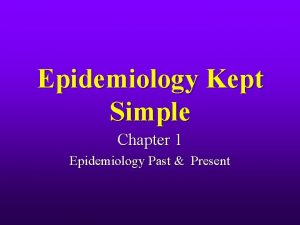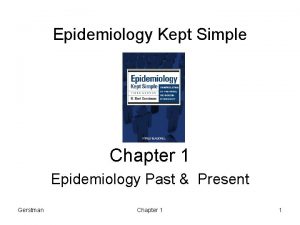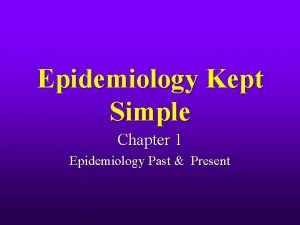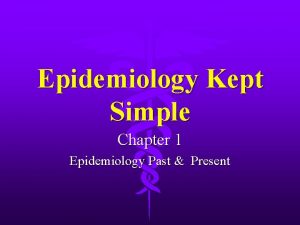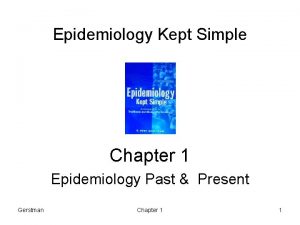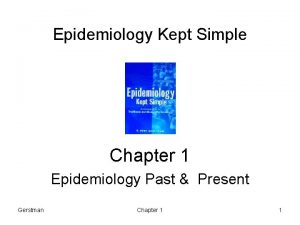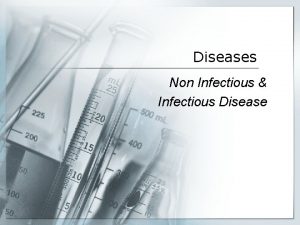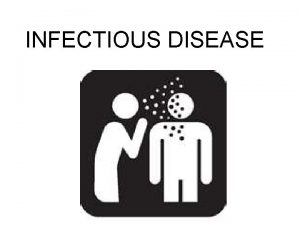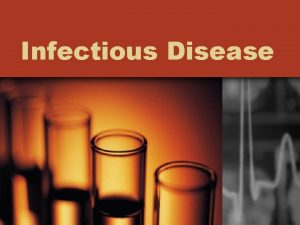Epidemiology Kept Simple Chapter 3 The Infectious Disease























- Slides: 23

Epidemiology Kept Simple Chapter 3 The Infectious Disease Process 6/4/2021 1

Reasons to Study Infx D. Epi • Infectious disease control, including emerging agents and bioterrorism • To illustrate general principals of epidemiology 6/4/2021 2

What is Infection? • Infection ≡ biologic agent is living and replicating within a host • Contamination ≡ agent living on exterior surface of host • Silent Infection ≡ infection without disease (“commensal”) • Infectious disease ≡ infection accompanied by pathology 6/4/2021 Pathos 3

Components of the Infx Disease Process 1. 2. 3. 4. 5. 6/4/2021 Agent Reservoir Portals of entry and exit Mode of transmission Immunity 4

1. Agents (from large to small) • Helminths (parasitic worms) • Fungi & yeast (parasitic plants, lack chlorophyll) • Protozoa (eucaryotes; complex life cycles) • Bacteria (independent reproduction) • Rickettsia (intracellular agents; require Ixodes tick carrier) • Viruses (submicroscopic; incapable of multiplication outside of host) • Prions (infectious proteins) 6/4/2021 5

2. Reservoirs • Reservoir ≡ where the agent multiplies and perpetuates • Types of reservoirs – – 6/4/2021 Cases [symptomatic] Carriers Animals & insects Inanimate objects 6

Carrier Reservoirs • Carrier ≡ contagious without discernable signs • Types of carriers – Inapparent [throughout] – Incubatory – Convalescent 6/4/2021 8

Animals Reservoirs (Zoonoses) • Zoonosis = an animal disease transmissible to humans Types of zoonoses • Direct zoonosis: vertebrate animal human (e. g. , rabies) • Cyclozoonoses: species #1 species #2 human species #1 (e. g. , Echinococcus tapeworm, right) 6/4/2021 Source: www. cdc. gov 9

Types of Zoonoses (cont. ) • Metazoonoses vertebrate animal invertebrate human e. g. , malaria (right) • Saprozoonoses vertebrate animal inanimate object human e. g. (coccidiomycosis) Valley fever 6/4/2021 10

Inanimate Reservoirs • • Water Food Soil Other 6/4/2021 11

Portals of Entry & Exit • • Respiratory Conjunctiva Urogenital Gastrointestinal Skin Placenta Etc. 6/4/2021 12

Transmission by Contact • Direct (host host) • Indirect (host secretion host) • Droplet (airborne, short distance) • Nuclei (airborne, suspended) 6/4/2021 13

Transmission via Intermediaries Vector (living) Vehicles (inanimate) Vectors types: mechanical, developmental, propagative, cyclopropagative. 6/4/2021 14

Transmission Dynamics Common source Serial transmission 6/4/2021 15

Transmission: Cycle in Nature Each agent has its unique cycle in nature Example: the blood worm (Shistosoma sp. ). 6/4/2021 16

Immunity • Immunity ≡ all factors that alter likelihood and severity of infection after host is exposed • Types of immunity (figure) 6/4/2021 17

Innate Immunity • Physical barriers: skin, cilia, mucosal, sheaths • Chemical barriers: acidity, enzymatic, etc. • Non-specific cellular & physiologic responses: phages, polymorphs, inflammation 6/4/2021 18

Acquired Immunity Cellular (immunocytes) Lymphocytes Granulocytes Non-cellular (humoral) Antibodies Cytokines 6/4/2021 19

Interaction of Innate & Acquired Immunity 6/4/2021 20

Immunization • Immunization ≡ the act of acquiring immunity • Active immunization ≡ host response to exposure (Natural exposure or artificial vaccination) • Passive immunization ≡ receipt of immunity products from others (Therapeutic e. g. , anti-serums or maternal (transplacental, colostrum) 6/4/2021 21

Types of Vaccines • Killed vaccine: killed agent, not capable of self-replication • Modified live vaccine: attenuated version of agent capable of replication • Toxoid: denatured toxin (no agent) 6/4/2021 22

Herd Immunity Non-susceptible individuals represented by dark circles. You do not need to vaccinate the entire herd to achieve infection control if the agent meets a lot of dead ends 6/4/2021 23

Herd Immunity Animation • http: //www. immunisation. nhs. uk/About_Im munisation/Science/Herd_immunity__animation 6/4/2021 24
 Epidemiology kept simple
Epidemiology kept simple Chapter 26 infectious disease prevention and control
Chapter 26 infectious disease prevention and control Infectious disease quality controls
Infectious disease quality controls Stages of infection
Stages of infection Stages of infectious disease
Stages of infectious disease Stridor
Stridor Infectious disease
Infectious disease Hennepin county infectious disease manual
Hennepin county infectious disease manual What is the smallest infectious agent
What is the smallest infectious agent Kept simple past
Kept simple past Kept simple past
Kept simple past Communicable disease and non communicable disease
Communicable disease and non communicable disease Infectious waste in hiligaynon
Infectious waste in hiligaynon Infectious canine hepatitis in dogs
Infectious canine hepatitis in dogs Icd 10 morbus hansen
Icd 10 morbus hansen Papillomitosis
Papillomitosis Infectious nucleic acid
Infectious nucleic acid Lead poisoning
Lead poisoning Infectious mononucleosis
Infectious mononucleosis Epidemiological triad of malaria
Epidemiological triad of malaria Hpps logo
Hpps logo Quizlet
Quizlet Infectious stunting syndrome
Infectious stunting syndrome Perbedaan odds ratio dan prevalence ratio
Perbedaan odds ratio dan prevalence ratio
